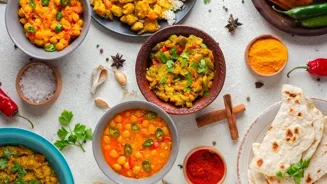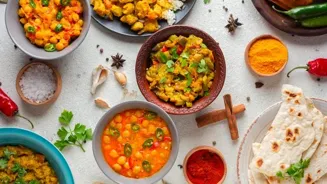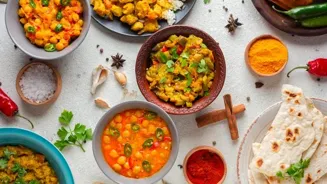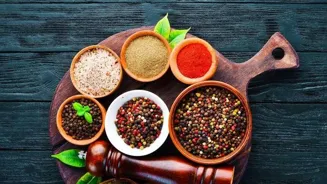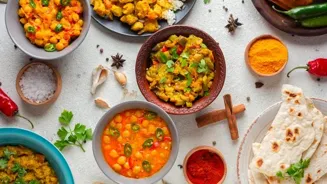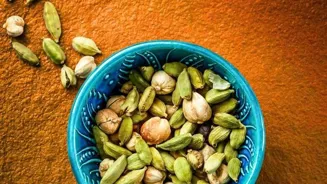Unravel the Secrets of Indian Thalis: A Balanced Meal Guide. Dive into the art of holistic nutrition and cultural significance
The Indian thali, a quintessential culinary experience, is more than just a plate
full of food; it's a holistic, balanced meal rooted in tradition and designed for optimal nutrition.
From the snow-capped Himalayas to the sun-kissed beaches of the South, every region boasts its unique thali, reflecting the local flavors, ingredients, and dietary preferences.
But the underlying principle remains the same: to provide a complete and satisfying meal that caters to all the body's needs. Let's delve into the secrets of the Indian thali and understand how it achieves this remarkable feat.
Thali's brilliance: harmonious blend of six tastes for holistic nutrition
The thali's brilliance lies in its inherent structure, ensuring a harmonious blend of the six fundamental tastes: sweet, sour, salty, bitter, pungent, and astringent.
Each taste plays a vital role in stimulating digestion, balancing doshas in Ayurveda (the ancient Indian system of medicine), and providing a diverse range of nutrients.
A typical thali includes cereals like roti or rice, providing carbohydrates for energy; dals or legumes, offering protein and fiber; vegetables, packed with vitamins and minerals; yogurt or curd, promoting gut health; and a sweet dish to round off the meal.
Pickles, chutneys, and papads add a burst of flavor and aid digestion. This carefully curated combination ensures a complete nutritional profile.
Regional Indian thalis balance flavors with spices for health
A North Indian thali might feature wheat-based rotis, dal makhani (black lentil stew), paneer butter masala (cottage cheese in a creamy tomato sauce), mixed vegetable curry, raita (yogurt with vegetables), and gulab jamun (deep-fried milk balls in syrup) for dessert.
Conversely, a South Indian thali could showcase rice, sambar (lentil-based vegetable stew), rasam (tamarind-based soup), vegetable thoran (dry vegetable stir-fry), curd rice, and payasam (sweet milk pudding). Despite the regional variations, the core principle of balance remains constant.
The skillful use of spices not only elevates the flavor profile but also aids digestion and possesses medicinal properties. Turmeric, for example, is known for its anti-inflammatory properties, while ginger and cumin can aid in digestion.
A thali offers a balanced mix of nutrients for overall health
The individual components of a thali work synergistically to provide a comprehensive nutritional package. Carbohydrates from grains provide energy, while proteins from dals and legumes are essential for building and repairing tissues.
Vegetables deliver a wealth of vitamins, minerals, and antioxidants, protecting the body against disease. Yogurt or curd promotes gut health, facilitating nutrient absorption and boosting immunity.
The inclusion of healthy fats, often in the form of ghee or nuts, is crucial for hormone production and brain function. The thali ensures that all these essential food groups are represented in appropriate proportions, contributing to overall well-being.
Thali symbolizes culture, tradition, and togetherness through food
Beyond nutrition, the thali also embodies cultural and social significance. It is often a symbol of hospitality, offered to guests as a gesture of warmth and generosity.
The act of eating from a thali is considered a mindful practice, encouraging diners to savor each element and appreciate the interconnectedness of the meal. The communal aspect of sharing a thali fosters a sense of togetherness and strengthens social bonds.
In many Indian households, the preparation and consumption of a thali are traditions passed down through generations, preserving culinary heritage and cultural values. It is a celebration of flavors, textures, and aromas, bringing people together and nourishing both body and soul.
Indian thali: a balanced, wholesome meal for optimal health
In our fast-paced modern lives, where convenience often trumps nutrition, the Indian thali offers a timeless solution for balanced and wholesome eating. Its inherent structure, diverse flavors, and cultural significance make it an ideal model for creating nutritionally complete meals.
By consciously incorporating the principles of the thali into our daily diets, we can ensure that we are receiving all the essential nutrients required for optimal health and well-being.
So, the next time you're looking for a satisfying and nutritious meal, consider the wisdom of the Indian thali and embark on a culinary journey that nourishes both body and soul. The beauty of the thali lies not just in its deliciousness but also in its simplicity and adaptability.
You can easily customize it to suit your individual dietary needs and preferences, ensuring a meal that is both healthy and enjoyable.
Embracing the diverse, flavorful thali as a culinary journey in India
The emphasis on fresh, seasonal ingredients is another key aspect of the thali. This not only enhances the flavor of the dishes but also ensures that you are getting the maximum nutritional benefits from the produce.
Local and regional variations of the thali further add to its appeal, allowing you to explore the diverse culinary landscape of India. From the fiery curries of Rajasthan to the delicate flavors of Kerala, each region offers a unique thali experience that reflects its distinct cultural identity.
Embracing the thali as a way of life can transform your relationship with food, encouraging mindful eating and fostering a deeper appreciation for the culinary heritage of India. It's a journey of flavors, textures, and traditions that nourishes both the body and the soul.
